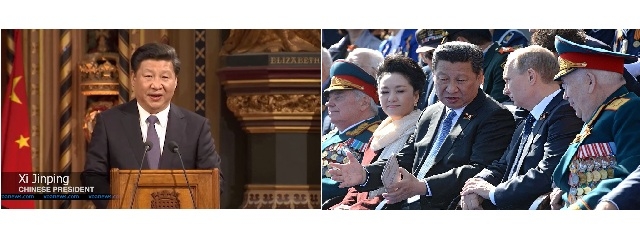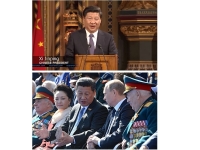Vips
CHINESE PRESIDENT XI JINPING SAID ANNUAL GROWTH TO BE NO LESS 6.5 % NEXT 5 YEARS
GOAL DOUBLING GDP AND PER CAPITA INCOME

(Source: wikipedia)
Chinese President Xi Jinping has said that the country's annual growth rate should be no less than 6.5 percent in the next five years to realize the goal of doubling GDP and per capita income by 2020 on the basis of 2010.
Xi Jinping was explaining a proposal for formulating the country's 13th Five-Year Plan at the Fifth Session of the 18th Communist Party of China (CPC) Central Committee.
Xi Jinping was explaining a proposal for formulating the country's 13th Five-Year Plan at the Fifth Session of the 18th Communist Party of China (CPC) Central Committee.
On Sunday, Chinese Premier Li Keqiang said average growth of more than 6.5 % is needed to meet the goal of achieving a 'moderately prosperous' society by 2020.
'Maintaining a medium-to-high level of growth is conducive to improving people's livelihoods so that they can truly benefit from the success of the country in comprehensively building a moderately prosperous society,' Xi Jinping was cited as saying by the Xinhua News Agency.
'Maintaining a medium-to-high level of growth is conducive to improving people's livelihoods so that they can truly benefit from the success of the country in comprehensively building a moderately prosperous society,' Xi Jinping was cited as saying by the Xinhua News Agency.
According to the new plan, China is set to promote the yuan and to change the way it manages its currency policy. The country is pushing hard for the yuan´s inclusion in the IMF´s Special Drawing Rights basket. Recently, the fund signaled that could happen in the near future.
The document, the CPC Central Committee's Proposal on Formulating the Thirteenth Five-year Plan (2016-2020) on National Economic and Social Development, was adopted at the Fifth Session of the 18th CPC Central Committee which ended Oct. 29. (Xinhuanet)
The document, the CPC Central Committee's Proposal on Formulating the Thirteenth Five-year Plan (2016-2020) on National Economic and Social Development, was adopted at the Fifth Session of the 18th CPC Central Committee which ended Oct. 29. (Xinhuanet)
As the capital of China, Beijing enjoys a prominent role as a symbol of China´s rise and increasing global stature. In addition to this diplomatic function, Beijing is also home to many multinational companies and international organizations and is increasingly becoming the center of gravity for China´s financial and economic decision making. At the same time, Beijing is located far from the relatively wealthy eastern and southern provinces that are home to China´s most lucrative consumer markets, and it is part of a regional economy that is overwhelmingly dominated by state-owned industry and has not benefitted as much as China´ssouthern and eastern coastal provinces from the export-led growth model of the last 3 decades. (Jpmorganchase)
Chinese cities are growing both in number and size. In 2000, there were about 55 million people living in 7 Chinese cities that had a population larger than 4 million. By 2009, the number of such large cities nearly doubled, to 13, and their combinedpopulation approached 100 million. Beijing and Shanghai, China´s two largest metropolises, each registered a more than 40 percent population expansion in one decade´s time and each has over 20 million residents now. A 2011
report by the McKinsey Global Institute predicts that by 2025 over a third of the world´s 600 largest cities will be in China, including 100 that are not yet on the list. (Jpmorganchase)
Ruby BIRD
http://www.portfolio.uspa24.com/
Yasmina BEDDOU
http://www.yasmina-beddou.uspa
report by the McKinsey Global Institute predicts that by 2025 over a third of the world´s 600 largest cities will be in China, including 100 that are not yet on the list. (Jpmorganchase)
Ruby BIRD
http://www.portfolio.uspa24.com/
Yasmina BEDDOU
http://www.yasmina-beddou.uspa
Ruby Bird Yasmina Beddou Goal Chinese President Xi Jinping Annual Growth Society Moderately Prosperous China Communist Party
Liability for this article lies with the author, who also holds the copyright. Editorial content from USPA may be quoted on other websites as long as the quote comprises no more than 5% of the entire text, is marked as such and the source is named (via hyperlink).






